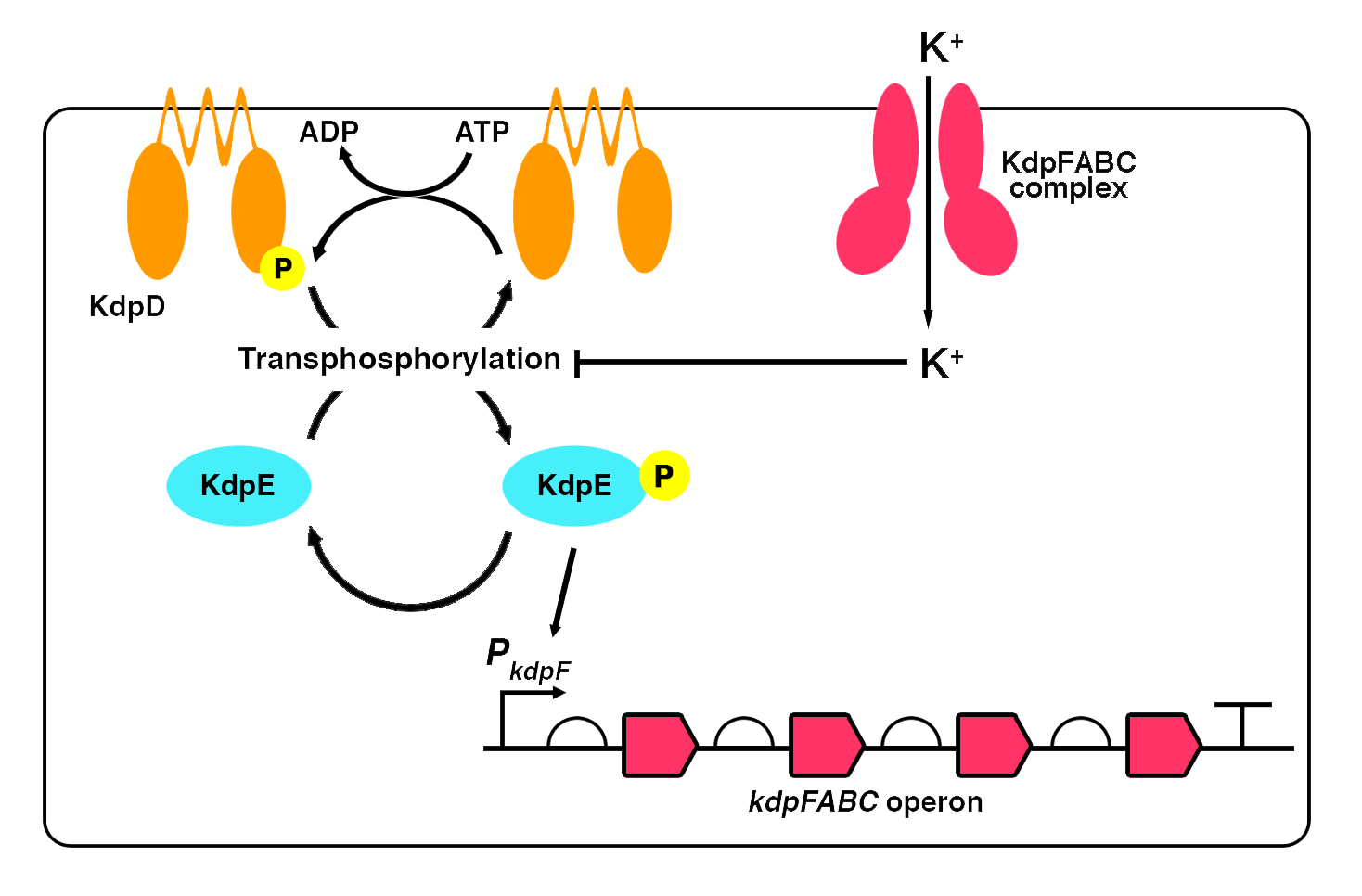Part:BBa_K1682004
PkdpF[-15, T>G]
G-mutant PkdpF - potassium responsive promoter
Contents
Biology of PkdpF
Potassium ion uptake in E. coli is regulated by several systems under different conditions. The potassium ion transporters, Trk and Kup are constitutively expressed (Epstein & Kim, 1971) while KdpFABC, another transporter is activated under low [K+] conditions (Laimins et al., 1981).
The kdpFABC operon is controlled by the KdpDE two-component system (TCS) which consists of KdpD, a membrane-bound sensor kinase, and KdpE, a cytoplasmic response regulator (Polarek, 1992; Walderhaug, 1992). KdpD is stimulated by both intracellular and extracellular K+ (Jung, 2000; Jung, 2001; Roe, 2000; Yan, 2011a; Laermann, 2013). KdpD phosphorylates KdpE upon low potassium concentration (Voelkner, 1993; Puppe, 1996; Jung, 1997a; Jung, 2000). Under an increase in [K+], KdpD phosphatase activity will be enhanced, causing a decrease in phospho-KdpE and kdpFABC expression. Phosphorylated KdpE turns on the expression of kdpFABC (Zhang, 2014a; Laermann, 2013).
We adopt the promoter PkdpF from kdpFABC operon with -28 position of transcription start site relative to start the first gene, kdpF. The -10 and -35 box elements have been mapped which are TACCCT and TTGCGA respectively (Sugiura et al., 1992). The transcription factor, phosphorylated KdpE, binds to the PkdpF at binding site located from -71 to -55 site with reference to the transcription start site (Sugiura et al., 1992; Narayanan et al., 2012).
Construction
To make a potassium-sensing device, we obtained the promoter, PkdpF, and combined it with a GFP reporter, BBa_E0240, in BioBrick RFC10 standard so that the promoter activity in different potassium level can be detected and characterized.
Removal of EcoRI illegal site
To make PkdpF compatible with RFC10 standard and, as so, readily accessible to iGEM community, we designed variants of it with the EcoRI site removed. We mutated the thymine at -15 position to guanine, cytosine and adenine. The wild type promoter and the 3 variants are expected to be different in activity because of the difference in binding energy between the promoter and RNA polymerase (Brewster, 2012). Therefore, we characterized all of them to compare their strengths by relative fluorescence intensity, so as to obtain comprehensive knowledge in the activity and working range of the four promoters. For convenience, we denote them as A mutant, G mutant and C mutant respectively in the following context.
Characterization
RPU measurement

In order to assemble a device that can be widely used by iGEM community, we characterized PkdpF by relative promoter unit (RPU) measurement. Additionally, relative fluorescence unit (RFU) measurement has also been done to compare the activities between wild type promoters and 3 variants.
At the lowest [K+], the strength of the G mutant promoter was found to be approximately 0.5 RPU. RPU of the promoter decreases as [K+] increases. At 0.025 mM [K+], RPU values was found to be 0.13. There was about 3.8 times change in RPU from 0 mM to 0.4 mM [K+]. As expected, PkdpF is turned off at high [K+] due to inhibition of KdpD kinase activity by K+.
RFU measurement of 3 mutants

Both C and G mutants expressed higher fluorescence compared to the wild type and the A mutant. As the [K+] went up, the activity of PkdpF decreased. The expression levels of both the C and G mutant promoters were significantly higher than the wild type promoter, while the A mutant was always the lowest. At 0 mM [K+], both the C and G mutants expressed fluorescence which was about 1.7 times higher than the A mutant and wild type promoter. At 0.2 mM [K+], expression of both C and G mutants were 1.7 times higher than the wild type promoter, and 3 times higher compared to the A mutant. This might be caused by the difference in binding affinity between RNA polymerase and PkdpF variants (Brewster, 2012). The dynamic range of our promoters is between 0 to 0.1 mM of K+.
Promoter function measurement in different strain
At [K+] lower than 0.0125 mM, the acitivity of G mutant in DH10B was significantly greater than that in TK2240 strain. The activity of PkdpF in DH10B strain decreased with increasing concentrations, while it remained stable in TK2240. Above 0.05 mM [K+], the activity of PkdpF in TK2240 strain exceeded that in the DH10B strain. We are uncertain about what causes the discrepancies in the comparisons.
- 10COMPATIBLE WITH RFC[10]
- 12COMPATIBLE WITH RFC[12]
- 21COMPATIBLE WITH RFC[21]
- 23COMPATIBLE WITH RFC[23]
- 25COMPATIBLE WITH RFC[25]
- 1000COMPATIBLE WITH RFC[1000]
//chassis/prokaryote/ecoli
//function/regulation/transcriptional
//function/sensor
//promoter
//regulation/negative
//rnap/prokaryote/ecoli/sigma70
| None |



